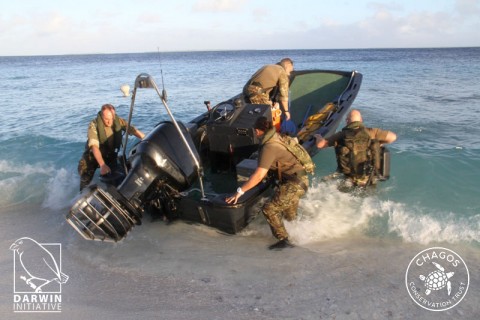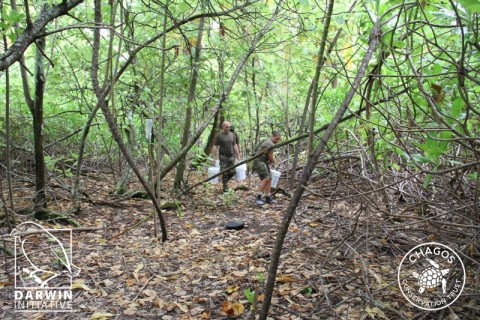Ile Vache Marine Bird Habitat Restoration 2014 - Getting the job done on Vache Marine…
Having successfully completed a swimming assessment (involving swimming clothed, in open lagoon water wearing an "assault" life-jacket, climbing in to the back of a military small boat in surf.......) Grant and I made our soggy way to the BPV Pacific Marlin. We were joined there by a small but crucial team from British Forces BIOT who were to assist us on our forthcoming task. Led by the ever-cheerful and hugely professional Corporal Richard "Nutty" Nutt Royal Marines, who was assisted by the stalwart Marine "PJ" McLeary, Leading Medical Assistant Dean Watterson Royal Navy (Submariner), Leading Regulator Charley Groves Royal Navy (Royal Overseas Police Officer) and Leading Chef Chris Faulkner (Royal Navy). This eclectic group of serviceman and women were a key element in making Phase One a success.
We departed Diego Garcia at midday on Friday 01 August 2014 and sailed overnight to be anchored of Vache Marine before first light and, most important, to meet the early morning high-tide. It was essential we launched the ageing but ideal for the job Rigid Raider as early as possible in order to ferry the 200 kg of rat poison on to the island from the beach. If we missed the tide we would have to cross-deck all the stores in to a kayak and paddle the poison in to the beach over the coral reef that surrounds Vache Marine. The surf can break heavy on the coral and it was not an option we wanted to take. So, in darkness we loaded the Raider and, as the first of the sun's rays warmed the eastern skies, we headed for Vache Marine.
The wind was blowing, as expected at this time of the year, from the Southwest, directly from the line we were heading. It was a fair wind and white-horses were cantering across the lagoon surface. The Raider was very heavily laden with the stores and seven people. As soon as the Raider was lowered over the stern of the mother craft, seawater came rolling over the bow of the boat. As we slowly edged away from the shelter of the ship waves came spraying over our bow and we were awash. It was a very long ten minutes for all of us as we ploughed our way to the shore of Vache Marine.
Fortunately, Cpl Nutty Nutts' suggestion of an early a start as safe was a good one. He managed to inch the Raider over the coral shelf, turn the boat around near the shore and ride a wave backwards on to the beach so he could pull away when the craft was unloaded. A fine display of coxswain's handling as any of us had witnessed with a difficult load in the boat. With two people holding the boat steady in the waves, the bait, water supply, medical equipment and personal gear was ferried above the shoreline.

Our first task on island was to map by GPS the lines that had been cut across the island for the laying of bait. Back in April 2014 on the Chagos Science Expedition, Pete Carr and the expedition Doctor, Jon Baillie had marked and provisionally mapped these lines and had cut the first 30 metres of eight of them in. In June, troops from BF BIOT had been on Vache Marine and completed the job. It was our job now to ensure these lines dissected the island at parallel 25 metre spaces. Bait had to be delivered to every 25 metre square on the island and, if the lines had wandered, an area where a sedentary pregnant female rat was nesting could be missed - and the mission would fail. It took nine baking hours and all of the first day to open up the trails where the prolific Scaevola had grown over, map the lines, way-point every 25 metre square where bait stations were to be left, study the lines to locate any gaps and then where necessary, cut intervening lines to fill those gaps. It was a very weary but content team that returned to the Pacific Marlin at the end of the day. This exercise also brought home the magnitude of the 2006 Eagle Island endeavour and, the promise from Pete that the future rat eradication projects in the Chagos would be conducted using modern technology (helicopters) not "good old tried and tested ways".......

After the BF BIOT team had ferried containers of bait to the start of every line on the island, day two saw Pete and Grant alone on the island. Armed with water, Personal Protective Equipment, radio and medical bag, they set off to hand-broadcast poisoned bait, north, south, east and west and on the spot, from every 25 metre square way point. The physical nature of this task under a tropical sun should not be under-estimated. Pete described it as "like continuously bowling at cricket while holding a heavy dead-weight in your free arm while opening an oven door". The task proved too much to achieve in one day, however, a spare day had been scheduled in to cater for such an outcome and day three saw the pair back to conclude the bait delivery to Grant's (the eradication expert) satisfaction. With the BF BIOT troops back on island, short work was made of clearing the island of all empty containers and stores and returning all to the welcoming showers and galley aboard the Pacific Marlin.
So, now back on Diego Garcia, we wait. On the 13th we will return to to Vache Marine and repeat the hand-broadcast and leave loaded bait stations. It may be that this first effort has eradicated rats from the island. On a temperate climate island this may be so. However, experience from around the globe has shown us this may not be the case on a tropical island, where food is always available and pregnant females (that could be missed), are present all year around......

